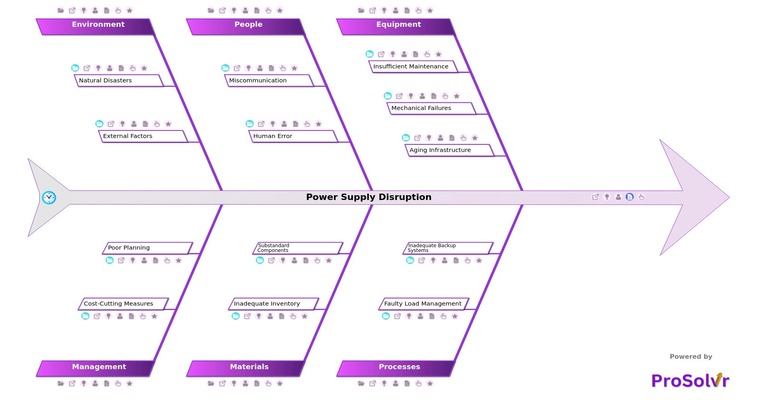Root Cause Analysis of Power Supply Disruption
Conducting a thorough root cause analysis (RCA) is essential to address and mitigate power supply disruptions effectively. When Haldia Petrochemicals faces inadequate power supply from their captive power plant, they typically resort to several contingency measures to maintain continuous operations. If grid power is not available or reliable, they can activate diesel generators to provide necessary power, although this is usually a more expensive option. They may also switch to grid power supplied by the state electricity board or other external sources to compensate for the shortfall.
The plant may prioritize power for essential processes and equipment to ensure that the most critical operations, such as maintaining the integrity of chemical processes, continue without interruption. They might use Uninterruptible Power Supply (UPS) systems or other energy storage solutions to provide short-term power support during the transition or until the regular power supply is restored. In some cases, Haldia Petrochemicals may enter into short-term agreements with external power suppliers to ensure an uninterrupted power supply during the downtime of their captive power plant.
A thorough root cause analysis helps identify the underlying causes of power interruptions, whether they are due to equipment failures, inadequate maintenance, or external factors such as grid issues. By pinpointing these root causes, Haldia Petrochemicals can implement targeted corrective actions to prevent recurrence. This might involve upgrading infrastructure, enhancing backup power systems, or improving maintenance protocols. A well-executed RCA with a visual RCA tool not only helps in rectifying existing problems but also aids in developing robust contingency plans, ensuring a more resilient power supply system and minimizing the risk of future disruptions.
Power supply disruptions at Haldia Petrochemicals can have severe implications for their operations. First and foremost, interruptions can lead to significant downtime, halting chemical production processes that are often sensitive to power fluctuations. This downtime not only affects the output but can also result in the loss of valuable raw materials and product batches, potentially leading to financial losses and decreased market competitiveness. Additionally, sudden power outages may cause damage to sensitive equipment and machinery, which can be costly to repair or replace, further exacerbating operational disruptions.
Who can benefit from the Power Supply Disruption in Haldia Petrochemicals template?
Several groups can benefit from the insights gained through the root cause analysis (RCA) of the power supply disruption in Haldia Petrochemicals:
- Operational Staff: RCA insights can help them understand the critical points of failure, improve their maintenance practices, and implement better procedures to avoid disruptions.
- Maintenance Teams: By understanding the root causes of past disruptions, maintenance teams can enhance their preventive maintenance schedules, adopt new techniques, and address potential weaknesses in the equipment.
- Safety and Compliance Officers: RCA findings can guide them in updating safety protocols and compliance measures to address vulnerabilities exposed by power disruptions, helping to prevent accidents and ensure regulatory adherence.
- Engineering and Technical Teams: They can gain insights into potential design flaws or inefficiencies in the power systems, leading to improvements in system design, upgrades, and the implementation of more robust technology.
- Management and Decision Makers: RCA results can help them understand the financial and operational impacts of power disruptions, enabling them to make informed decisions on investments in infrastructure, contingency planning, and risk management strategies.
Why use this template?
Haldia Petrochemicals can greatly benefit from a root cause analysis (RCA) of power supply disruptions by gaining a clear understanding of the underlying issues affecting their power systems. This Gen-AI powered root analysis enables them to pinpoint specific weaknesses, whether they lie in equipment, maintenance practices, or procedural shortcomings. By addressing these root causes, Haldia Petrochemicals can implement targeted improvements, enhance the reliability and efficiency of their power supply, and reduce the risk of future disruptions. Ultimately, this proactive approach helps minimize operational downtime, ensures compliance with safety regulations, and supports more informed decision-making, leading to greater overall stability and productivity in their plant operations.
Draft and create a template for problem analysis in ProSolvr by smartQED.








